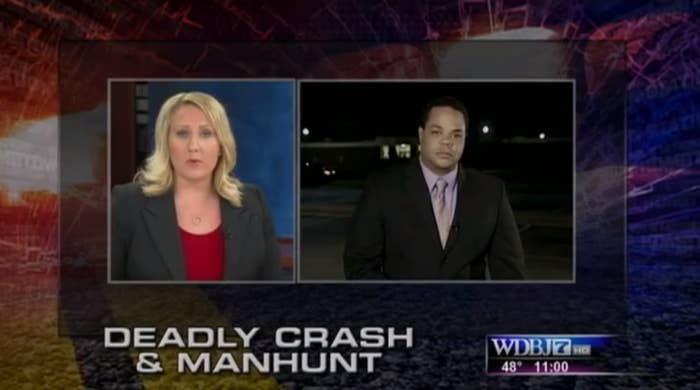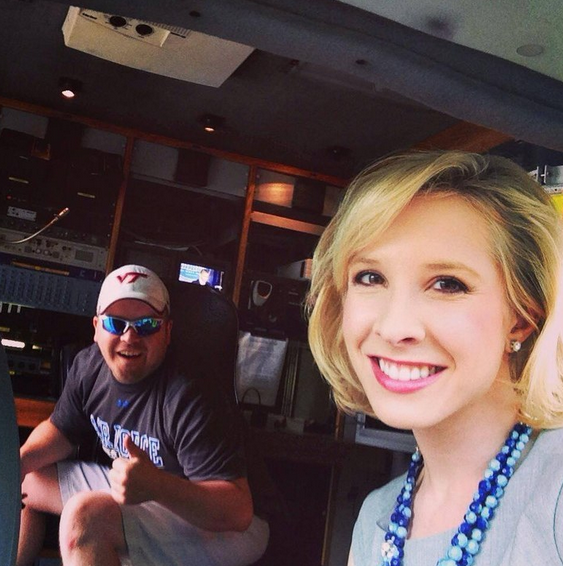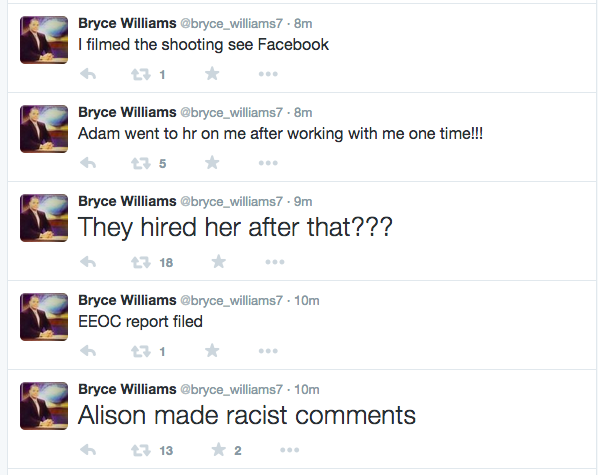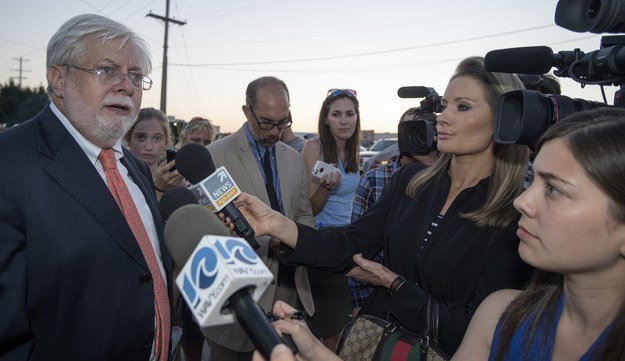
Internal memos from Vester Flanagan's 10 months at WDBJ detail his contentious working relationships with the station's cameramen and his belief that then-intern Alison Parker, whom authorities said he shot and killed on live television Wednesday, had made racist remarks toward him.
These files, posted online by 8 News WRIC Richmond, are part of court record from a civil lawsuit that Flanagan filed against the station in March 2014, a year after he was fired. In the lawsuit, Flanagan claimed that he had suffered harassment, racial and sexual discrimination, and retaliation while employed at WDBJ before he was terminated.
The internal memos tell a different story, detailing how Flanagan — who used the name Bryce Williams on television and social media — began exhibiting troubling behavior that left his co-workers feeling "threatened or uncomfortable" on three separate occasions during his first month and a half at the station.
On May 31, 2012, two months after Flanagan's March 29 start date, then-WDBJ news director Dan Dennison wrote to Flanagan about an argument with a reporter that resulted in the reporter and two photographers who observed the incident feeling threatened.
Dennison also noted two separate incidents where Flanagan tried to control the way his interviews were recorded and criticized the photographers working with him on the assignments in a way that made the photographer and the interviewee feel uncomfortable.
Flanagan had particularly difficult relationships with the station's photographers, the documents show.
In a another memo titled "Behavioral Improvement and Expectations," sent to Flanagan in June, Dennison wrote, "There is no doubt in my mind that you want to do well at WDBJ7 and have an overarching desire to please. However, your behavior continues to cause a great deal of friction with your co-workers, particularly your photographer teammates. You must make improvements immediately or you will face termination of employment."
"It seems that you are taking the actions of many of the photographers quite personally and misinterpreting their actions or words," Dennison wrote. "Clearly much damage has been done already in your working relationships with several members of the photography staff. It is your responsibility, going forward, to work at repairing these relationships, as the station cannot be put in the position of making assignments based on the inability of team members to get along." He told Flanagan that he was required to contact the station's Health Advocate employee assistance program and set up a meeting, or else he would be fired.
"We can no longer afford to have you engage in behaviors that constitute creation of a hostile work environment," Dennison wrote.
At Flanagan's 90-day performance evaluation on Aug. 8, 2012, he was given an "unacceptable" review in the category related to interpersonal relationships and working together effectively with other members of the news team, with Assistant News Director Dave Seidel citing his inability to get along with cameramen.
"Bryce communicates with the assignment desk and has worked to improve his scripting with producers," Seidel wrote. "The area where Bryce must make immediate improvement is with photographers. This issue is well-documented and has been discussed."

Flanagan's nine-month review, on Dec. 24, 2012, detailed extensive issues with his work performance, a separate issue from the interpersonal issues raised in the documents.
According to a memo written after the meeting, during the review, Dennison said that the reporter had "plateaued," saying that he and others at the station had "serious concerns" about Flanagan's "news-gathering, time management skills, and on-air performance." A repeated criticism was Flanagan's tendency to "repeat, rather than do original reporting and use critical thinking and questioning skills to produce truly memorable reporting." Dennison said that this led to "thinly sourced material and a lack of substance in your final work."
"Avoid being merely a human tape recorder," he wrote, ending the meeting by telling Flanagan to improve within two weeks or face disciplinary action that could include termination from employment.
According to meeting notes that appear to be written by Seidel on Jan. 14, Flanagan had made sufficient improvement to keep his job, but he was still having trouble working with photographers assigned to his stories.
A photographer named Trevor Fair had apparently gone to management after working with Flanagan on a story and reported that the journalist attempted to enter a home without permission to find an interview suspect, according to the documents. Flanagan disputed the cameraman's version of events and said that "he felt like he was being thrown under the bus," according to the documents.
Later in the January meeting, Seidel writes, "the discussion at one point returned to Bryce's relationship with photographers. I encouraged Bryce to take their counsel. I suggested that he think of them as one of the first viewers of the story."
"I encouraged Bryce to give them the benefit of the doubt and to not view [the photographers] as meddling in a reporter's business."
At a news conference on Thursday, WDBJ General Manager Jeff Marks said, "At that point, he raised some concerns with HR of perceived unfairness, which were immediately investigated and found to be without merit."

According to another memo, written on Jan. 21 by Assistant News Director Greg Baldwin, Flanagan told a colleague about a possible discrimination incident directed at him by Alison Parker, who at the time was an intern at the station and went by Alison Bailey.
Bryce "talked about two incidents with a former intern, Alison Bailey. He said Zach Irby, also an intern at the time, was present when Alison made a couple of statements that he thought were racist. One was something about 'swinging' by some place, the other was out in the 'field,'" the memo read.
Around that time, Marks said Thursday, "he confronted an anchor who was assigned to review one of his scripts."
At that point, management made the determination that Flanagan needed to be separated from the company. On Feb. 1, two news managers and the HR business partner notified Flanagan of the decision to terminate his employment. He reacted angrily, telling them that they would have to call the police because he was going to "make a stink and it was going to be in the headlines."
Flanagan refused to leave his desk, and police arrived. Flanagan then had a particular interaction with photographer Adam Ward, who would become one of his victims:
"Bryce then turned his attention to [chief photographer] Lynn Eller who was standing in the hallway and said he was a 'big fat...' and flipped him off," Dennison wrote in a termination report. "This was being recorded by Adam Ward; Bryce turned his attention to him said something about paparazzi, told Adam he needed to 'lose your big gut,' and again flipped the camera off."
Flanagan filed a complaint of harassment and discrimination with the federal Equal Employment Opportunity Commission. Marks on Thursday said "WDBJ7 responded that his claims of mistreatment were unfounded and the EEOC denied the claim."
Shortly after Wednesday's shooting, Flanagan sent out these tweets — followed by his own video of the fatal attacks.

Flanagan then filed a civil lawsuit against the station in Roanoke court.
In his lawsuit, Flanagan issued a subpoena to many employees, including Adam Ward, and requested the personnel files of more than 20 employees, including Ward and Parker.
"What I encountered while employed at WDBJ-7 was nothing short of vile, disgusting, and inexcusable," Flanagan wrote in a letter to Roanoke city general district court judge Francis Burkhart.
"There was a carefully orchestrated effort by the photography staff to oust me — a conspiracy," Flanagan wrote. "The chief photographer, Lynn Eller, even told the photographers to 'roll on me' if they caught me doing something wrong," he wrote. In apparent reference to Adam Ward, he continues, "why did one of the photographers go to HR on me after working with me ONLY ONCE. There was nothing to report!"
"Why was it that NOT ONE SINGLE producer complained about me? Why were complaints made only by photographers with the exception of one reporter who was a known bully?"
"Your Honor, I am not the monster here. i get along with my current co-workers AND I was just recognized by a senior manager at corporate. That sure doesn't sound like the monster I was painted to be," Flanagan, who was representing himself, wrote.
The lawsuit was dismissed, Marks said on Thursday. "We don't settle for significant amounts," he added.
Marks on Thursday also said that after Flanagan was fired, he encountered employees in public places — but there were no confrontations and he never tried to enter the building.
Upon hiring Flanagan, Marks said "our HR team followed up on references from a variety of sources and they all came back positive."
"I think anybody can make positive references happen if they try hard enough so we exhausted our processes on that," Marks added, saying, "I don't think he was the strong applicant we've ever had, but he passed muster for our news management at that time."

Vester Flanagan was employed by WDBJ7 as a reporter between March 2012 and February 2013.Flanagan applied for the position using the air name of Bryce Williams. As part of WDBJ's standard protocol his background check resulted in positive references.Flanagan's job performance and his interaction with his co-workers led his manager to place Flanagan on a succession of performance improvement plans. Only slight improvement was noted each time.Flanagan was placed on a final warning in December 2012 for failure to check his facts in a news story and, generally, for poor news judgment.In January 2013 he accused a photographer of making trouble for him by questioning a decision to go on private property in pursuit of a story. At that point, he raised some concerns with HR of perceived unfairness, which were immediately investigated and found to be without merit.Shortly after that, he confronted an anchor who was assigned to review one of his scripts.At that point, management made the determination that he needed to be separated from the company.On February 1, two news managers and the HR business partner notified Flanagan of the decision to terminate his employment. He reacted angrily, telling them that they would have to call the police because he was going to "make a stink and it was going to be in the headlines."The HR rep called 911. Employees had been notified to give Flanagan space to clean out his desk. At his desk, Flanagan attempted to reach the corporate CEO, without success. At that point, police arrive and escorted him from the building. On the way out, he handed a wooden cross to the news director and said, "You'll need this." He also made a derogatory comment to Adam Ward as he left.The only contact between WDBJ7 and Flanagan after that were routine calls to HR about termination benefits.Shortly thereafter, Flanagan filed a complaint of harassment and discrimination with the Equal Employment Opportunity Commission. WDBJ7 responded that his claims of mistreatment were unfounded and the EEOC denied the claim. He later filed a civil action in local court in Roanoke. That action was dismissed.In two and half years since the termination, WDBJ7 employees reported seeing Flanagan in public places and there were no confrontations. He was never seen following employees and he did not attempt to enter the offices of WDBJ7.All claims of mistreatment were investigated by senior management, by the HR representative and legal counsel. All investigations determined that no reasonable person would have taken any of the cited instances as discrimination or harassment.
Stephanie McNeal contributed to this article.
